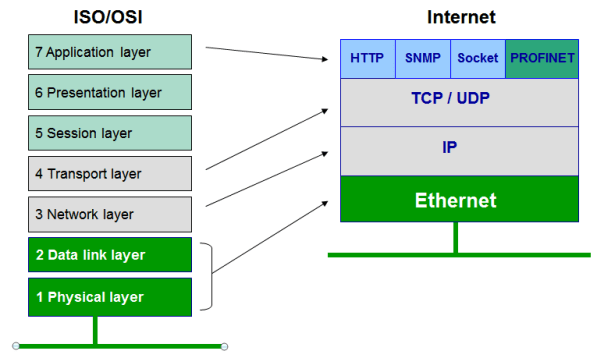Carl’s pet peeve number three*: Ethernet is not a protocol.
IMS Research found that the number one industrial Ethernet protocol is “Ethernet TCP/IP.”
VDC found the leading industrial Ethernet protocol is “Ethernet.”
Ethernet is not a protocol! I ranted about this before, way back in 2006: “Why Use Industrial Ethernet?” So today I’ve counted to ten and will move from rant mode to education mode.
Networking is characterized in the ISO/OSI reference model. Its seven layers define the functions of various aspects of networks. Wikipedia has a complete explanation: OSI Model. The Internet Model collapses the layers to four.
Laye rs 1 and 2 are defined by IEEE802.3 which we know as “Ethernet.” To overstate this: Ethernet is just the Physical layer and the Data Link layer. By itself Ethernet does nothing; it’s just the “pipe.” What comes down the pipe? Whatever IP sends down the pipe (when TCP/IP is used). IP is at layer 3. IP sends the message it received up to layer 4, TCP. So what do TCP and IP do? Just send the message on to where they’re told. Up at the top of the stack is the application layer, at layer 7. The application layer is where the protocol resides. Only the application layer actually does more than send the message along its way. (What happened to layers 5 and 6? They are neither needed nor used.)
rs 1 and 2 are defined by IEEE802.3 which we know as “Ethernet.” To overstate this: Ethernet is just the Physical layer and the Data Link layer. By itself Ethernet does nothing; it’s just the “pipe.” What comes down the pipe? Whatever IP sends down the pipe (when TCP/IP is used). IP is at layer 3. IP sends the message it received up to layer 4, TCP. So what do TCP and IP do? Just send the message on to where they’re told. Up at the top of the stack is the application layer, at layer 7. The application layer is where the protocol resides. Only the application layer actually does more than send the message along its way. (What happened to layers 5 and 6? They are neither needed nor used.)
Now, IP and TCP are not the only choices for layers 3 and 4, respectively. You can substitute UDP at layer 4 for example. Or you can skip them altogether like Address Resolution Protocol (ARP) does; it goes straight from layer 2 to an application.
PROFINET takes a lesson from ARP. It skips TCP and IP for real-time messages. TCP and IP (aka “the stack”) is implemented in software. Rather than let PROFINET real-time messages languish in the stack, we skip it. This improves speed and determinism. (See the Industrial Ethernet Book article for details: “Technical Article: Performance metrics for Industrial Ethernet”.)
So, when users respond to IMS and VDC and say their Industrial Ethernet protocol is “Ethernet,” what do they mean? I would not accept this answer if I were a market research company! So what do they mean? Do they mean web server? A real Industrial Ethernet protocol? A Proprietary protocol? “I have no blooming idea what a protocol is?”
What do you think they mean?
–Carl Henning
*Number one: Wireless is not monolithic: “Wireless or Wireless”
Number two: Why can’t Control Engineers and IT get along? (Although there is certainly improvement in this relationship from five years ago.)
More on Industrial Ethernet:
